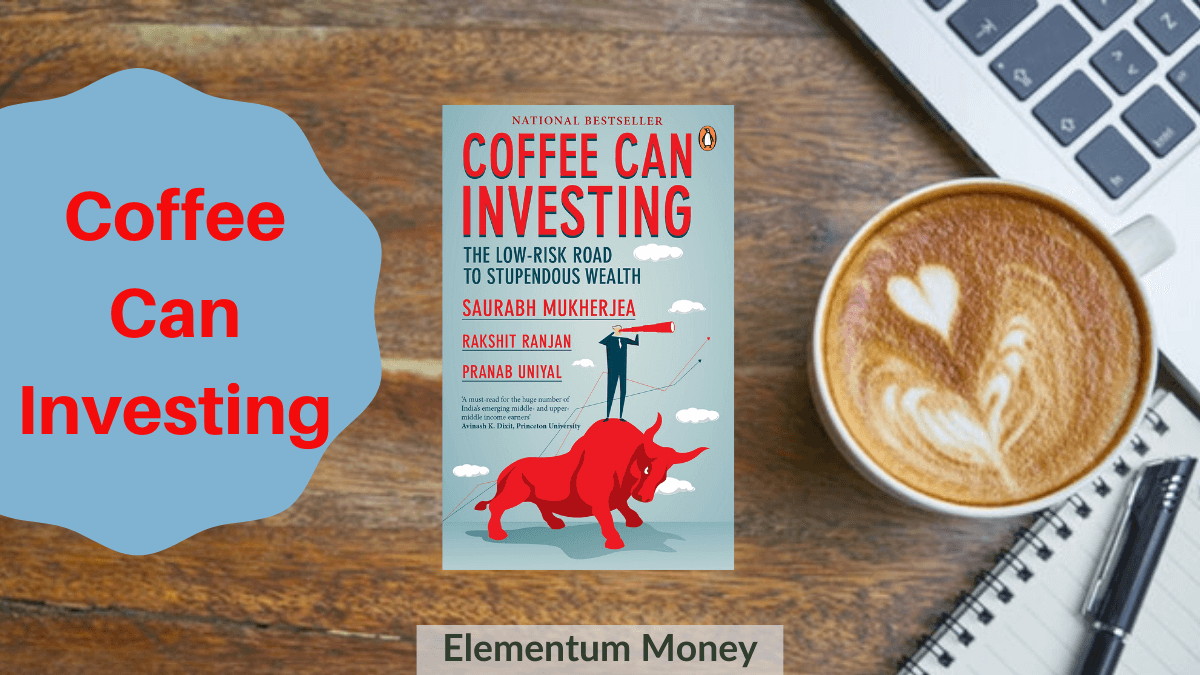Having read so many Personal Finance books thanks to piquing of interest and with a bid to finding books to cover on the blog, I now find myself up against two challenges. One, almost all books that I have read end up giving examples from the American market, which may or may not hold true in the Indian circumstances. Two, most books end up doling out the same few golden principles, sometimes in much worse language than what I might have encountered earlier. The book I am covering here – Coffee Can Investing – still did have quite a few of the golden rules I am well aware of but then reading about it in the Indian context made it a refreshing change.
About the book – Coffee Can Investing
The book, Coffee Can Investing – Low risk road to stupendous wealth published in 2017, is a recent addition to the still nascent stock of personal finance books in India. Written by the trio of Saurabh Mukherjea, Rakshit Ranjan and Pranab Uniyal, all from Ambit Capital the book looks at a more rational asset allocation through the stories of two individuals and their flawed investing history. Ambit Capital, as the name suggests is a capital finance firm embracing a lot of services in it’s ambit! Asset management and private wealth management are two of the umpteen offerings that they proffer.
It’s a short read with a lot of anecdotes, numbers and examples as well as supporting graphs and diagrams. For an Indian context, the book seemed to imbibe and talk on such similar lines as I personally believe in, that for a major part of it I found myself nodding to what I read. To give you an idea on just why you should pick up this book, I will touch upon 5 key takeaways from it hoping to give a good sampler and incentive to buy a copy.
5 key takeaways from Coffee Can Investing
1. Coffee Can Portfolio
The term Coffee Can Investing was first devised by Robert Kirby in the US when he discovered the stupendous growth in the portfolio of a client who had mostly ignored his sell calls and just remained status quo. Why Coffee Can? The concept of “Coffee Can” is derived from the Wild West when native Americans would stuff all their savings into a coffee can, put it under a mattress and forget about it. Sounds very Indian, right? In some ways, demonetization was the spilling of the Indian Coffee Can.
Before I digress, coffee can portfolio refers to the idea of constructing a portfolio of a few stocks with strong fundamentals and leaving it untouched for the next ten years. Yes, ten years. That is also the type of portfolio promoted and sold by Ambit Capital as a PMS (Portfolio Management System).
Personally, I can vouch for the idea. I have now seen a lot of client direct equity portfolios where they have literally bought stocks at the time that they got listed and not touched them. Now, those stocks have fattened up, grown in value by multiple times and sitting comfortably I their demat accounts.
What’s the risk of such a portfolio? Every company will not keep growing over time, right? There are enough instances of companies like Enron, Satyam, Jet Airways and even DHFL which go from rockstars to completely bust in that period. The authors wisely put in that with time and compounding, the strong grow stronger and the pulling down of the laggards keeps going down in proportion to the entire portfolio.
If I had to put the coffee can investing philosophy in perspective, a few quarter results do not a company make. Invest in a company that you believe, hold on and watch the magic unfold.
2. How to filter companies for your portfolio?
The main idea behind this book is to simplify Personal Finance and especially Equity investing. Even to identify those companies, the book gives a very simple three-number theory. One, consider companies with a minimum Rs. 100 Crore market capitalization. The second and third numbers are in a way twin filters to consider the top and bottom lines of the company in question.
The top line is seen through a consistent revenue growth of more than 10{76b947d7ef5b3424fa3b69da76ad2c33c34408872c6cc7893e56cc055d3cd886} over the last ten years. On the other hand, the bottom line is seen through the returns generated on the capital employed in the company. The authors recommend considering a company with atleast 15{76b947d7ef5b3424fa3b69da76ad2c33c34408872c6cc7893e56cc055d3cd886} ROCE in the last 10 years. As Charlie Munger says, in the long run no company’s stock price can go too much higher than the returns it generates on the capital. The 15{76b947d7ef5b3424fa3b69da76ad2c33c34408872c6cc7893e56cc055d3cd886} is a figure arrived at by considering a risk free return rate of 8{76b947d7ef5b3424fa3b69da76ad2c33c34408872c6cc7893e56cc055d3cd886} in India.
What is obviously missing in this is the subjective aspect of good management. To me, this remains an important yet very tricky part to nail down in analyzing a stock.
3. The Small Wonder
The authors make a very important point of how in the long run, small cap stocks perform better than the average large cap universe in most markets. In India too, there have been long sustained periods of superlative returns from small caps. Considering how moody small caps are, of course there are also enough bleeding periods which is why small cap investing is only for the money that will not be required for a long time.
Why would small cap stocks do better? Two major reasons offered by the authors made sense to me. First, smaller companies have a larger market to penetrate and bigger scope to grow. Second, small companies often take time to be “discovered” by equity analysts. Most analysts follow and cover a limited number of companies. However, when a good quality small company is suddenly discovered by the analysts then they also race that quickly.
There is obviously a much-needed note of caution too. Small cap companies are also much more of a hit or a miss. If they have a higher scope to grow, the probability of failure for dearth of resources, especially in bad economic cylces is also pretty high. So, in this segment, professional management through mutual funds or a wealth management company is far more necessary than the more stable large cap stocks. To me, this advice holds true for mid cap stocks also where some are future large caps and some just there to be written on the pages of history.
4. The trap of real estate
We Indians have always had our love for two physical assets – gold and real estate. Honestly, earlier in the absence of well-established financial markets and systems, you couldn’t blame investors for wanting to put their money into something tangible. But, today, is it still wise?
When it comes to real estate investing, especially in the residential space, the authors answer with an unequivocal no. In a way, they covered a lot of arguments made by me in an earlier post. Not only are the returns not on par with equity markets, but the assets are illiquid as well with very high transfer costs.
Why then are Indians still so enamoured by and convinced of the returns that the lure of land can provide them? This is where I had a eureka moment in the book. Compare the average holding period of real estate with that of equities. As the authors rightly point out, instinctively and sometimes thanks to the logistics of it, most investors end up adopting the coffee can approach to real estate by holding to the asset for much longer periods. It’s funny how many of them have told me with glee about their property doubling in 7-10 years (of course without taking into account costs or tax) and then not believing that mutual funds could have done better for them.
They usually see real estate investments as being safer than their stock investments. What they don’t realise is this is because of the inadvertent Coffee Can style of investing they adopt in real estate as against the trading style in their stock portfolios, i.e. when it comes to real estate, investors are happy to buy and hold for long periods of time.
– Coffee Can Investing, Saurabh Mukherjea, Rakshit Ranjan, Pranab Uniyal
5. The importance of financial planning
Are you wondering why this point features last on my list? Nope, the importance of it has not diminished. However, financial planning is the basis of almost any financial call and it has to form the skeleton and the basis of our financial lives. In this aspect, this one quote from the book gives a good idea on it’s importance:
It is critical for an investor to nail down objectives and bake them into a financial plan. The exercise helps match the investor’s financial goals with the kind of risk that needs to be taken in the portfolio.
– -Coffee Can Investing, Saurabh Mukherjea, Rakshit Ranjan, Pranab Uniyal
Final take
If you are operating in the Indian market and looking for a good manual to provide some crucial guidelines to your investing process, this book should find a place in your reading list soon enough. However, make note that this is still not a wholesome financial planning guide.
If I had to point my finger to two things that were missing from it, I would look at the emotional aspect of making financial decisions and the risk management aspect of it through insurance. But then, this book really promises only to educate about Coffee Can Investing and there it sure delivers on it’s promise.
Have you read the book? What did you make of it? Let me know in the comments below.





Leave a Reply